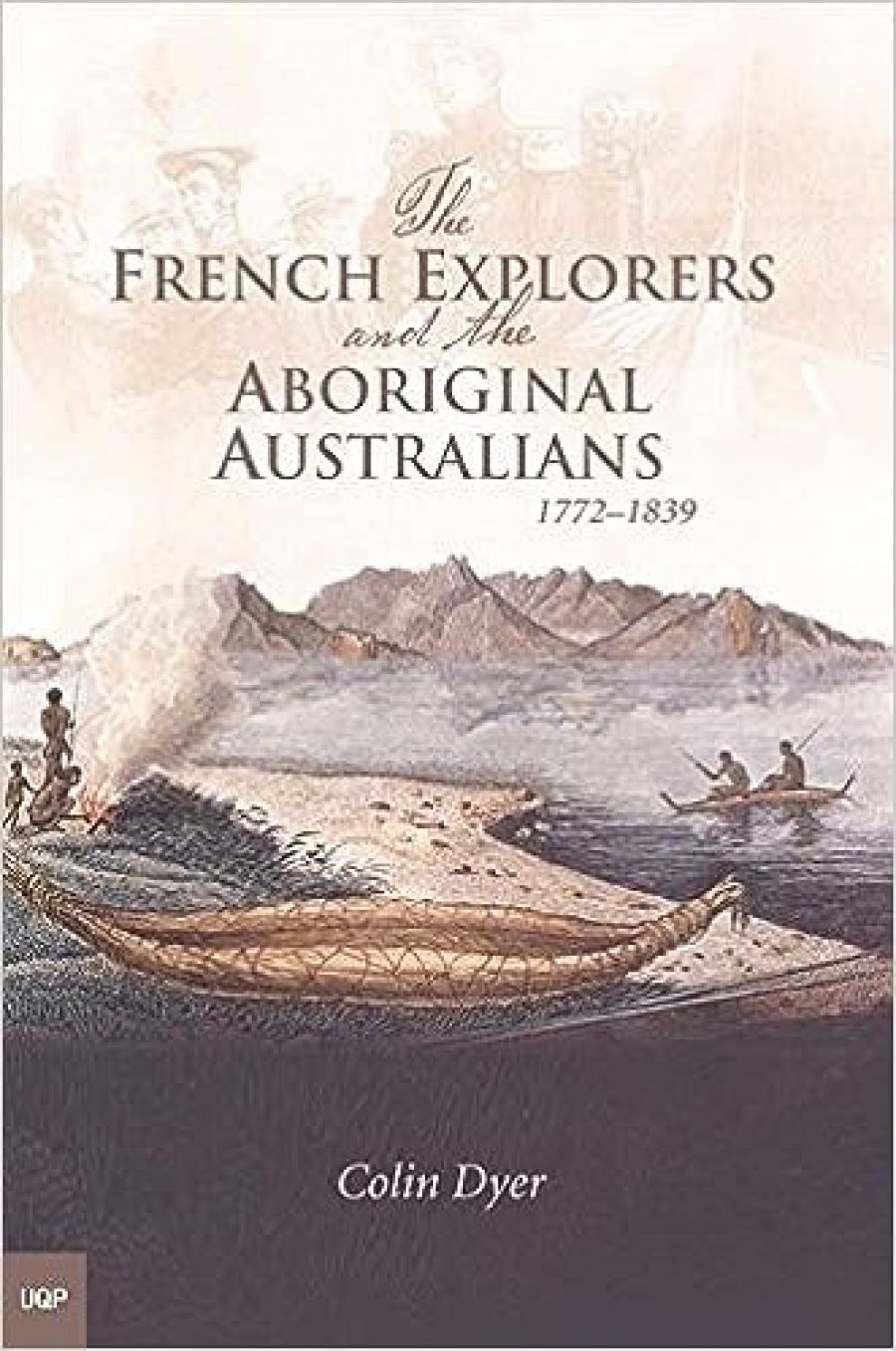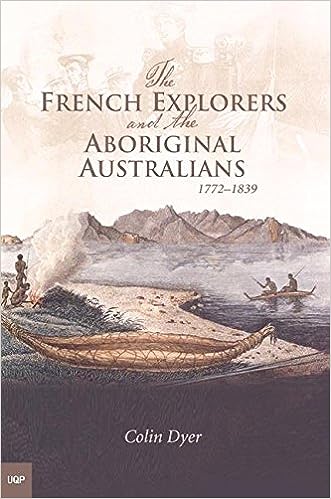
- Free Article: No
- Contents Category: History
- Review Article: Yes
- Article Title: Absolument nus
- Online Only: No
- Custom Highlight Text:
In this book, Colin Dyer draws on the writings of French explorers from ten expeditions spanning the years between 1772 and 1839. His aim is ‘to enable readers to make as close an acquaintance as possible directly with the French explorers and the Aboriginal Australians during their encounters’. He presents the material with little contextual information or analysis, maintaining that he has ‘no personal axe to grind … no thesis or argument to prove, no preconceived conclusion to impose’. This stance, as we will see, has its advantages and its limitations.
- Book 1 Title: The French explorers and the Aboriginal Australians 1772–1839
- Book 1 Biblio: UQP, $32.95 pb, 240 pp
- Book 1 Cover Small (400 x 600):

Given Dyer’s reluctance to involve himself in his narrative, other than in the ordering of his material, the text itself at times reads like a French compendium of information on Aboriginal Australians. We begin with the first stages of early anthropological observation, the process of recounting and classifying. Here there are descriptions of the Aborigines’ teeth (‘large, regular and white’), their skin (deceptively darker in appearance than its actual ‘reddish colour’) and their eyes (in 1792, expressing a ‘sweetness and kindness’, but, only ten years later, caution, anxiety and mistrust). Physically, the Aborigines displayed few positive attributes, leading Citizen Péron, dubbed l’imprudent by Baudin, to challenge the ‘baneful oratory’ of Rousseau and his followers who idealised the ‘state of nature’.
The French showed a curiosity, relative sympathy and respect for the objects of their relentless gaze. There are also moments when the mutual regard the Europeans and Australians held for each other was evident. After a long session around a fire, for example, Labilladière, a member of D’Entrecasteaux’s expedition, noted that the inhabitants, though unresponsive to the violin (‘they gave [the player] to understand that their ears were hurting’), liked the flute and ‘attempted more than once to charm us by songs … with the modulation of which I was singularly struck … Several times two of them sang the same tune at once, but always one third above the other, forming a concord with the greatest justness’. Much that they saw remained impenetrable to the French, but it was clear that the Australians had elaborate rituals of hospitality and reciprocity and that their children, loved, protected and nurtured, retained a place of importance in tribal life. In early encounters, the Aborigines greeted the odd-looking visitors with joy and observed them at close range with a childlike delight.
Underlying many of the French explorers’ observations was a basic assumption about the nature of human progress and the relationship between natural ability, industriousness and innovation. That the Tasmanians ate shellfish but made no effort to catch fish puzzled the French. It seems that the Tasmanians may have eliminated fish from their diets in order not to have to embark on an unnecessary labour when shellfish abounded and required little effort to gather and consume. Thus, regardless of the fact that the French did see mainlanders fishing, a general observation began to emerge: the Australians had little initiative and were seemingly incapable of imagining the concept of improvement. Their diet of lizards, grubs and roots, their ‘wretched’, ramshackle, temporary ‘dwellings’, and their basic level of artistic achievement and technical originality (the brilliance of the boomerang throwers notwithstanding) all attested to what came to be regarded as an economy of effort and then laziness. Surely a more appetising manner of cooking one of their staples, the kangaroo, other than burying it whole in a fire, might have been discovered? Baudin was to write: ‘the only manifestations of industry that we saw were their spears and a not very dangerous club.’
The Australians were, almost without exception, absolument nus or only scantily covered. While curious about European attire, they displayed no desire to acquire it. Attempts at offering garments were not rebuked but, in due course, the French noticed their ‘gifts’ discarded nonchalantly along paths into the bush. At first the nudity did not generate much reflection on the part of the French, suggesting as it did a kind of innocence, if not purity. But by the time of the later expeditions, the nudity of Aborigines in Port Jackson roused a different response. That the English permitted the Australians to roam naked through the town indicated not an acceptance of them as they were, but something more sinister from the French viewpoint. It indicated that, for the settlers, the Aborigines were beneath contempt, unworthy of attention. The French did not idealise the Aborigines as would be the case for inhabitants of the more luscious and enticing tropics. Indeed, many of the observations of the French evoke all the prejudices of the times, and their own colonial record is hardly unblemished. Nevertheless, the almost total disregard on the part of the British for ‘the humanity’ of the Aborigines separated these French explorers from the settlers.
The entertainments of the colonists demonstrated the derisory attitude of the British toward the Aborigines. Staged battles involving Aboriginal men and women were common in public houses, but that the richest colonists also reproduced such spectacles for their private pleasure and that of their wives and their guests surprised, even outraged, the French. Dyer notes the reaction of Jacques Arago on witnessing the ‘deadly duels’ fought between Aborigines in Sydney in 1819: ‘What can be the aim of the English in permitting and even encouraging and provoking these hideous struggles? Can they be doing to these men what they do to aggressive dogs? Do they wish, in their culpable lack of concern, to let this race annihilate itself?’
Dyer’s enterprise brings with it a freshness and an immediacy: he succeeds in doing what he set out to do and allows us to see the Australians through the eyes of the French. With slightly more effort the book could have been improved, however. For example, we have no idea of the significance of the material presented in terms of its place in the writings as a whole. A brief bibliographical note describing the original sources and outlining the publication details of the various printed editions (including translations) of the cited works would have addressed this and provided the basis for a critical evaluation of the evidence. In addition, some introductory remarks on the historical background would have given readers unfamiliar with events in France in the revolutionary period a sense of the aspirations and inherent contradictions embedded in the actions of ‘enlightened’ men abroad. So, to complement this book, I would recommend the sumptuously produced Encountering Terra Australis: The Australian Voyages of Nicolas Baudin and Matthew Flinders (2004), by Jean Fornasiero et al., which presents a very thoughtful comparative analysis of the ideals and motivations of the French scientists and artists exploring the southern Australian coastline in the early years of the nineteenth century.


Comments powered by CComment